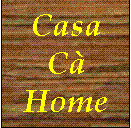


Piedmontese Grammar
Ve have seen that in Piedmontese there are verbs that make use of the auxiliary "avèj" (to have) for composite tenses and other verbs that make use of the auxiliary "esse" (to be) in the composite tenses. This is for the active form (passive and reflexive forms make use of the auxiliary "esse". So we first give some information on this point.
Use of auxiliary verbs
In active form, transitive verbs, that can support a direct object, make use in their conjugation of the auxiliary verb avej (to have). Intransitive verbs, that can be only active, usually make use of the auxiliary verb esse (to be) but some of them use the auxiliary verb avej (to have). Some of the intransitive verbs can use both auxiliary verbs in different circumstances with different meaning. We use the following table:
| ..... aux. verb form ............ |
esse (to be) | avej (to have) |
| Active | Intransitive verbs if not listed on the right I have gone = mi i son andàit Impersonal generical verbs It has been decided = A l'é stàit decidù Motion verbs related to a point of departure and/or arrival I flew to Turin = I son volà a Turin The verbs smijé (to seem)and dventé (to become) It seemed to me = A l'é smijame. - I became = Mi i son diventà |
Transitive verbs I have taken = mi i l'hai pijà Intransitive verbs expressing an action of the body or of the spirit to run, to belive. - I ran = Mi i l'hai corù . I belived = Mi i l'hai chërdù Impersonal meteo verbs It rained = A l'ha piovù Intransitive verbs of movement if used in a srictly literal sense I have flown = Mi i l'hai volà (expressing the action of my body that flew) The verbs podej (to be able), vorej (to want), dovej (to have to) I had to go = Mi i l'hai dovù andé . |
| Passive | All the passive verbs (transitive) . |
none |
| Reflexive | All the reflexive verbs (transitive) . |
none |
| Reciprocal | All the reciprocal verbs . |
none |
As usual we give some examples, also reporting the italian form, in order to underline some difference.
| English | Italian | Piedmontese |
| I have drunk | io ho bevuto | i l'hai beivù (transitive) |
| I have slept | io ho dormito | i l'hai durmì (intrans. it can be used also (seldom) as a trans.) |
| It has snowed | é nevicato | a l'ha fiocà (impersonal, intrans. and seldom trans. different with respect Italian) |
| I couldn't go | non sono potuto andare | i l'hai nen podù andé (difference with respect Italian) |
| I have flown with a little plane | ho volato con un piccolo aereo | i l'hai volà con un cit avion (intransitive) |
| I was invited | sono stato invitato | i son ëstàit anvità (passive) |
| we've written each other for one year | ci siamo scritti per un anno | i soma scrivusse për n'ann (reciprocal) |
| I've flown to you | Sono volato da te | I son volà da ti (intransitive) |
| It seemed (to) me | mi è sembrato | a l'é smiàme (used as intrans. ) |
| we've felt (ourselves) well | ci siamo trovati bene | i l'oma trovasse bin (idiom - difference with respect Italian) |
INDICATIVE MOOD (Meud indicativ)
| Present (present) |
Past (imperfect) (ampërfet) |
Past (pres. perf. (passà) |
Perfect (passà lontan) |
Past perfect (trapassà) |
Past perfect remote (trapassà lontan) |
Future. (futur sempi) |
Future perfect. (futur anterior) |
| mi i son ti it ses chiel a l'é noi i soma voi i seve lor a son |
mi i j'era ti it j'ere chiel a l'era noi i j'ero voi i j'ere lor a j'ero |
mi i son ëstàit ti it ses ëstàit chiel a l'é stàit noi i soma stàit voi i seve stàit lor a son ëstàit |
mi i fure ti it fures chiel a fur noi i furo voi i fure lor a furo |
mi i j'era stàit ti it j'ere stàit chiel a l'era stàit noi i j'ero stàit voi i j'ere stàit lor a j'ero stàit |
mi i fure stàit ti it fures ëstàit chiel a fur ëstàit noi i furo stàit voi i fure stàit lor a furo stàit |
mi i sarai ti it saras chiel a sarà noi i saroma voi i sareve lor a saran |
mi i sarai stàit ti it saras stàit chiel a sarà stàit noi i saroma stàit voi i sareve stàit lor a saran stàit |
SUBJUNCTIVE MOOD (Meud congiuntiv)
| Present (present) |
Imperfect (ampërfet) |
Past (passà) |
Past Perfect (trapassà) |
| che mi i sia che ti it sie che chiel a sia che noi i sio che voi i sie che lor a sio |
che mi i fussa che ti it fusse che chiel a fussa che noi i fusso che voi i fusse che lor a fusso |
che mi i sia stàit che ti it sie stàit che chiel a sia stàit che noi i sio stàit che voi i sie stàit che lor a sio stàit |
che mi i fussa stàit che ti it fusse stàit che chiel a fussa stàit che noi i fusso stàit che voi i fusse stàit che lor a fusso stàit |
CONDITIONAL MOOD (Meud condissional)
| Present (present) |
Past (passà) |
| mi i sarìa ti it sarìe chiel a sarìa noi i sarìo voi i sarìe lor a sarìo |
mi i sarìa stàit ti it sarìe stàit chiel a sarìa stàit noi i sarìo stàit voi i sarìe stàit lor a sarìo stàit |
IMPERATIVE MOOD (Meud amperativ)
| Present (present) |
Future (futur) |
| - - - - sie (esse) ch'a sia soma sie (esse) ch'a sio |
- - - - it saras a sarà i saroma i sareve a saran |
IMPERSONAL MOODS (Meud ampersonaj)
| ..Infinitive (anfinì)... | Participle (partissipi) | ...Gerund (gerundi)... |
| Present (present) | Past (passà).... | Present (present) | Past (passà).... | Present (present) | Past (passà)... |
| esse | esse stàit | - - - - | stàit (stàita) | essend (an essend) | essend ëstàit |
We note that the verb "esse" uses the euphonical particles l' e j' in front of voices beginning by vowel, the first particle at the third singular person of the Present and of the Imperfect (and in derived composite tenses), the second particle in the other voices of the same tenses. This changes if attached to the verb there is the locative adverbial particle i, that corresponds to the english "there, here" and to the italian ci, vi.
We have to see the corresponding english meaning of the verb "esse" with locative. "To be there" = "essie".
I am there, I am here, I am present, I will be there, I will be present, ... and so on, but also I am present with my mind, I've got it in a figurative sense, are all expressions that can be translated using the locative particle (adverb) "i". This locative is connected, in general, to the personal verbal pronoun with a hyphen. This happens also with the verb "esse", but the euphonical particle "l'" or "j' disappears. So, for example, the present of the verb "esse" with locative becomes:
mi i-i son, ti it i-i ses (euphonical addition of "i"), chiel a-i é, noi i-i soma, voi i-i seve, lor a-i son..
the english expression "there is" is translated into "a-i é"
The past imperfect of the verb "esse" with locative becomes:
mi i-i era, ti it i-i ere (euphonical addition of "i"), chiel a-i era, noi i-i ero, voi i-i ere, lor a-i ero..
For the other tenses the rule is the same as for all the verbs:
I will be there = mi i-i sarai, as for the other moods You would have been there = Ti it i-i sarìe stait.
We have already seen the use of the euphonical particle i after the pronoun it.
But there is another particularity: when in addition to the locative i also the partitive na is present. In this case the third singular persons of the present and imperfect maintain the "j'" (also for the present, instead of "l'"), according to the example:
he is = chiel a l'é ; he is here, there is = (chièl) a-i é ; there is some = a-i na j'é ; there are some = a-i na son
he was = chiel a l'era ; he was there, there was = (chièl) a-i era ; there was some = a-i na j'era
Now we want to see the conjugation of "esse" with object complement "lo (la) = him, (her), it". The verb is then "to be ... him" = "ess-lo". We have seen that in simple tenses the pronoun "lo" is located between pers. verbal pronoun and verb. With the verb "esse" we have to take into account the euphonical particles. We have:
For the Present tense: I am it, you are it, etc. = mi i lo son, ti it lo ses chiel a 'l l'é, noi(àutri) i lo soma, voi(àutri) i lo seve, lor(àutri) a lo son. For the Past imperfect tense: io lo ero, to lo eri, etc.mi i lo j'era, ti it lo j'ere, chièl a 'l l'era, noi(àutri) i lo j'ero, voi(àutri) i lo j'ere, lor(àutri) a lo j'ero. For the other tenses the general rules are valid.
Another particular situation is about the conjugation of "essje" = "to be ... to him". This is similar to the case of locative, where the adverbial particle i changes into the pronominal particle j. Then:
For present: I am ... to him, you are ... to him, etc = mi i-j son, ti it i-j ses, (ti it jë ses), chièl a-j é, noi(àutri) i-j soma, voi(àutri) i-j seve, lor(àutri) a-j son.
For imperfect: io gli ero, tu gli eri, etc = mi i-j era, ti it i-j ere, (ti it jë ses), chièl a-j era, noi(àutri) i-j ero, voi(àutri) i-j ere, lor(àutri) a-j ero.
We still note that when the past participle "stàit" is preceded by a word ending by consonant, assumes a prostethical ë. Example : you have been = ti it ses ëstàit.
We have seen three particula conjugations of "esse" connected with pronominal or adverbial particles. Here we give a list of these cases, reporting only the infinitive:
- To be ... it (to be that) = ess-lo
- To be ... to him/(her)/it = essje
- To be there = essie
- To be ... oneself = ess-se
- To be ... oneself ... of it = ess-s-ne
- To be ... oneself ... it = ess-s-lo
- and so on
The first singular person of the future can be mi i sarai or mi i sareu and this is always a correct Piedmontese.
THe gerund present has two forms: essend and an essend, and so is for the past: essend ëstàit e an essend ëstàit
The past participle is in agreement with the gender and the number of the subject. John has been = Gioan a l'é stàit , Mary has been = Maria a l'é stàita , Mary and Margareth have been = Maria e Ghitin a son stàite, and so on.
INDICATIVE MOOD (Meud indicativ)
| Present (present) |
Past (imperfect) (ampërfet) |
Past (pres. perf. (passà) |
Perfect (passà lontan) |
Past perfect (trapassà) |
Past perfect remote (trapassà lontan) |
Future. (futur sempi) |
Future perfect. (futur anterior) |
| mi i l'hai ti it l'has chiel a l'ha noi i l'oma voi i l'eve lor a l'han |
mi i l'avìa ti it l'avìe chiel a l'avìa noi i l'avìo voi i l'avìe lor a l'avìo |
mi i l'hai avù ti it l'has avù chiel a l'ha avù noi i l'oma avù voi i l'eve avù lor a l'han avù |
mi i l'avire ti it l'avires chiel a l'avir noi i l'aviro voi i l'avire lor a l'aviro |
mi i l'avìa avù ti it l'avìe avù chiel a l'avìa avù noi i l'avìo avù voi i l'avìe avù lor a l'avìo avù |
mi i l'avire avù ti it l'avires avù chiel a l'avir avù noi i l'aviro avù voi i l'avire avù lor a l'aviro avù |
mi i l'avrai ....(mi i l'avreu) ti it l'avras chiel a l'avrà noi i l'avroma voi i l'avreve lor a l'avran |
mi i l'avrai avù ti it l'avras avù chiel a l'avrà avù noi i l'avroma avù voi i l'avreve avù lor a l'avran avù |
SUBJUNCTIVE MOOD (Meud congiuntiv)
| Present (present) |
Imperfect (ampërfet) |
Past (passà) |
Past Perfect (trapassà) |
| che mi i l'àbia che ti it l'àbie che chiel a l'àbia che noi i l'àbio che voi i l'àbie che lor a l'àbio |
che mi i l'avèissa che ti it l'avèisse che chiel a l'avèissa che noi i l'avèisso che voi i l'avèisse che lor a l'avèisso |
che mi i l'àbia avù che ti it l'àbie avù che chiel a l'àbia avù che noi i l'àbio avù che voi i l'àbie avù che lor a l'àbio avù |
che mi i l'avèissa avù che ti it l'avèisse avù che chiel a l'avèissa avù che noi i l'avèisso avù che voi i l'avèisse avù che lor a l'avèisso avù |
CONDITIONAL MOOD (Meud condissional)
| Present (present) |
Past (passà) |
| mi i l'avrìa ti it l'avrìe chiel a l'avrìa noi i l'avrìo voi i l'avrìe lor a l'avrìo |
mi i l'avrìa avù ti it l'avrìe avù chiel a l'avrìa avù noi i l'avrìo avù voi i l'avrìe avù lor a l'avrìo avù |
IMPERATIVE MOOD (Meud amperativ)
| Present (present) |
Future (futur) |
| - - - - àbie (avèje) ch'a l'àbia avoma avèje ch'a l'àbio |
- - - - it l'avras a l'avrà i l'avroma i l'avreve a l'avran |
IMPERSONAL MOODS (Meud ampersonaj)
| ..Infinitive (anfinì)... | Participle (partissipi) | ...Gerund (gerundi).. |
| Present (present) | Past (passà).... | Present (present) | Past (passà).... | Present (present) | Past (passà)... |
| avèj (avèje) | avèj avù | - - - - | avù | avend (an avend) | avend avù |
We've see, while speaking about pronominal particles, their "interference" with the euphonical l' of the verb "avèj". The verb avèj has this consonant in all its voices. Here we gove a summary of these particularities and then we will note some possible variation in the conjugation.
With particle lo/la (singular object complement), the particle itself becomes 'l (ël) and the euphonical l' remains: I have it = mi i 'l l'hai
With particle je (plural object complement), the particle itself becomes -j(ël) and the euphonical l' becomes j': I have them = mi i-j j'hai , He has then = chièl a-j j'ha, etc.
With particle na (partitive), the particle itself becomes 'n(ën) and the euphonical l' becomes n': I have some = mi i 'n n'hai
The situation changes if the verbal pronoun is it (second sing. pers.):
With the singular pronoun lo this latter becomes ël: you have it = ti it ël l'has
With the plural pronoun j an euphonical i is added: so you have them = ti it i-j j'has but also ti it j'has
With the partitive pronoun na this latter becomes ën: so you have some = ti it ën n'has
Variations for the verb "avèj" that are part of the correct piedmontese language:
- The first singular person of the Present Indicative can be: mi i l'hai or mi i l'heu
- The first singular person of the Future Indicative can be: mi i l'avrai or mi i l'avreu
- The Subjunctive Imperfect has also the form: che mi i l'hèissa, che ti it l'hèisse, che chièl a l'hèissa, che noi i l'hèisso, che voi i l'hèisse, che lor a l'hèisso
- The Present Infinitive has two forms: avèj or avèje
- The second singular person of the Present Imperative can be: abie, or avèj, or avèje
- The second plural person of the Present Imperative can be: avèj, or avèje
- The Present Gerund can be: avend, or an avend or avenda
- The Past Gerund can be: avend avù, or an avend avù

